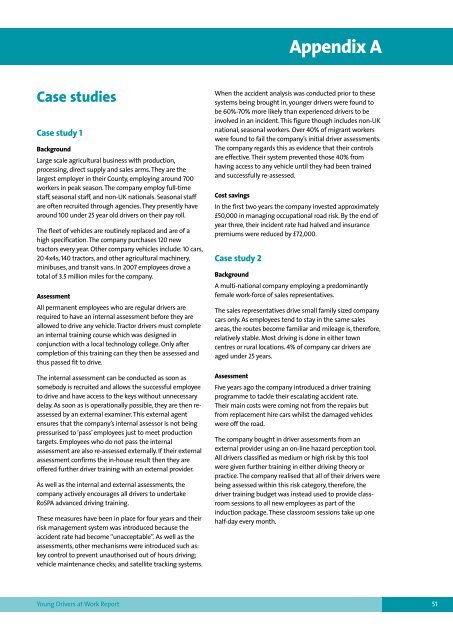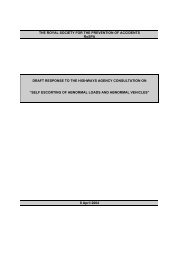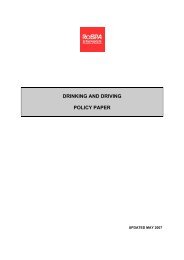RoSPA Young Drivers at Work Report
RoSPA Young Drivers at Work Report
RoSPA Young Drivers at Work Report
Create successful ePaper yourself
Turn your PDF publications into a flip-book with our unique Google optimized e-Paper software.
Appendix A<br />
Case studies<br />
Case study 1<br />
Background<br />
Large scale agricultural business with production,<br />
processing, direct supply and sales arms. They are the<br />
largest employer in their County, employing around 700<br />
workers in peak season. The company employ full-time<br />
staff, seasonal staff, and non-UK n<strong>at</strong>ionals. Seasonal staff<br />
are often recruited through agencies. They presently have<br />
around 100 under 25 year old drivers on their pay roll.<br />
The fleet of vehicles are routinely replaced and are of a<br />
high specific<strong>at</strong>ion. The company purchases 120 new<br />
tractors every year. Other company vehicles include: 10 cars,<br />
20 4x4s, 140 tractors, and other agricultural machinery,<br />
minibuses, and transit vans. In 2007 employees drove a<br />
total of 3.5 million miles for the company.<br />
Assessment<br />
All permanent employees who are regular drivers are<br />
required to have an internal assessment before they are<br />
allowed to drive any vehicle. Tractor drivers must complete<br />
an internal training course which was designed in<br />
conjunction with a local technology college. Only after<br />
completion of this training can they then be assessed and<br />
thus passed fit to drive.<br />
The internal assessment can be conducted as soon as<br />
somebody is recruited and allows the successful employee<br />
to drive and have access to the keys without unnecessary<br />
delay. As soon as is oper<strong>at</strong>ionally possible, they are then reassessed<br />
by an external examiner. This external agent<br />
ensures th<strong>at</strong> the company’s internal assessor is not being<br />
pressurised to ‘pass’ employees just to meet production<br />
targets. Employees who do not pass the internal<br />
assessment are also re-assessed externally. If their external<br />
assessment confirms the in-house result then they are<br />
offered further driver training with an external provider.<br />
As well as the internal and external assessments, the<br />
company actively encourages all drivers to undertake<br />
<strong>RoSPA</strong> advanced driving training.<br />
These measures have been in place for four years and their<br />
risk management system was introduced because the<br />
accident r<strong>at</strong>e had become “unacceptable”. As well as the<br />
assessments, other mechanisms were introduced such as:<br />
key control to prevent unauthorised out of hours driving;<br />
vehicle maintenance checks; and s<strong>at</strong>ellite tracking systems.<br />
When the accident analysis was conducted prior to these<br />
systems being brought in, younger drivers were found to<br />
be 60%-70% more likely than experienced drivers to be<br />
involved in an incident. This figure though includes non-UK<br />
n<strong>at</strong>ional, seasonal workers. Over 40% of migrant workers<br />
were found to fail the company’s initial driver assessments.<br />
The company regards this as evidence th<strong>at</strong> their controls<br />
are effective. Their system prevented those 40% from<br />
having access to any vehicle until they had been trained<br />
and successfully re-assessed.<br />
Cost savings<br />
In the first two years the company invested approxim<strong>at</strong>ely<br />
£50,000 in managing occup<strong>at</strong>ional road risk. By the end of<br />
year three, their incident r<strong>at</strong>e had halved and insurance<br />
premiums were reduced by £72,000.<br />
Case study 2<br />
Background<br />
A multi-n<strong>at</strong>ional company employing a predominantly<br />
female work-force of sales represent<strong>at</strong>ives.<br />
The sales represent<strong>at</strong>ives drive small family sized company<br />
cars only. As employees tend to stay in the same sales<br />
areas, the routes become familiar and mileage is, therefore,<br />
rel<strong>at</strong>ively stable. Most driving is done in either town<br />
centres or rural loc<strong>at</strong>ions. 4% of company car drivers are<br />
aged under 25 years.<br />
Assessment<br />
Five years ago the company introduced a driver training<br />
programme to tackle their escal<strong>at</strong>ing accident r<strong>at</strong>e.<br />
Their main costs were coming not from the repairs but<br />
from replacement hire cars whilst the damaged vehicles<br />
were off the road.<br />
The company bought in driver assessments from an<br />
external provider using an on-line hazard perception tool.<br />
All drivers classified as medium or high risk by this tool<br />
were given further training in either driving theory or<br />
practice. The company realised th<strong>at</strong> all of their drivers were<br />
being assessed within this risk c<strong>at</strong>egory, therefore, the<br />
driver training budget was instead used to provide classroom<br />
sessions to all new employees as part of the<br />
induction package. These classroom sessions take up one<br />
half-day every month.<br />
<strong>Young</strong> <strong>Drivers</strong> <strong>at</strong> <strong>Work</strong> <strong>Report</strong><br />
51
















